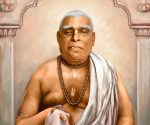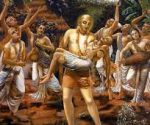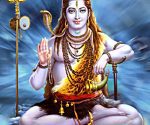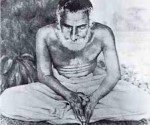If Rupa Goswami Had Not Come
Sri Srimad Bhaktivedanta Narayana Gosvami Maharaja
Vrndavana, India
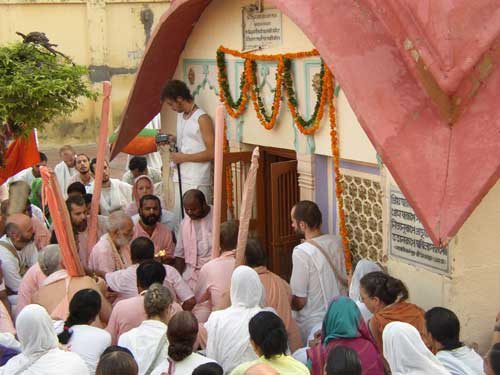 [This discourse was given in front of Srila Rupa Gosvami’s samadhi at Sri Radha-Damodara Mandira:]
[This discourse was given in front of Srila Rupa Gosvami’s samadhi at Sri Radha-Damodara Mandira:]Today we are very fortunate to be here at the bhajana-sthali and samadhi-sthali (sthali means place) of Srila Rupa Gosvami, here at Sri Radha-Damodara Temple.
Srila Rupa Gosvami is the life of the Gaudiya Vaisnavas. He is the crest-jewel of the rasika-bhaktas (devotees who taste transcendental mellows) and it is he alone who fulfills the mano-bhistham, the heartfelt desire, of Sri Caitanya Mahaprabhu. We have performed our worship of him, and we pray to his lotus feet that his conceptions may manifest in our heart. We pray that the manner in which he served Sri Gauranga Mahaprabhu and Sri Sri Radha-Krsna may also manifest in our heart.
If Srila Rupa Gosvami had not come to this world, the flood of mercy created by Sri Caitanya Mahaprabhu – the gift of service to Srimati Radhika – would have stopped when the Lord disappeared. Sri Krsna came to this world as Sri Caitanya Mahaprabhu for two reasons. The first reason was to taste His three unfulfilled desires. *[See Endnote 1] The second reason was to distribute to the world the path of spontaneous devotion (raga-marga) following in the wake of Sri Krsna’s Vrndavana associates), and especially the service of Srimati Radhika. Sriman Mahaprabhu manifested in the heart of Sri Rupa Gosvami and inspired him to write all his transcendental literatures, especially Bhakti-rasamrta Sindhu, Ujjvala Nilamani and later Vidagdha-madhava.
Before Sri Caitanya Mahaprabhu appeared here, people hated parakiya-rasa. They had a bad idea about it. Even other sampradayas – like the Sri (Laxmi) Sampradaya of Srila Ramanujacarya and also the Nimbarka sampradaya – were against the worship of Radha-Krsna to such a degree that they separated the Deity of Radha from the Deity of Govinda in Jaipur.
Srila Rupa Gosvami established the true conception of Sri Caitanya Mahaprabhu by his books. He especially used the Srimad-Bhagavatam as evidence to establish that parakiya-rasa is not only bona fide, but is the highest expression of devotion. He established this truth in such a strong way that all the other sampradayas had to bow their heads and accept it.
What would have happened if Srila Rupa Gosvami had not appeared in this world?
Vraja-prema – the prema of the dasya, sakhya, vatsalya, and especially the prema of the gopis – was contained in a storehouse. There are so many types of gopi-bhava, namely sneha, mana, pranaya, raga, anuraga, bhava, mahabhava. All these definitions were given by Srila Rupa Gosvamipada.
The “definition” verse of Srimad-Bhagavatam contains its essence:
ete camsa-kalah pumsah
krsnas tu bhagavan svayam
[“All of the above-mentioned incarnations are either plenary portions or portions of the plenary portions of the Lord, but Lord Sri Krsna is the original Personality of Godhead.” (Srimad Bhagavatam, 1.3.28)]
But Srila Rupa Gosvami showed us how to obtain that Supreme Lord of all, by giving definitions for all the stages of devotion to Him. What is sneha? What is maan? What is pranaya? What is raga? What is anuraga? What is bhava? What is madana-bhava? What is madanakya mahabhava? *[See Endnote 2] He gave definitions for sraddha, nistha, ruci, suddha-sattva and bhava bhakti. *[See Endnote 3] He manifested the definition of sadhana bhakti:
krti-sadhya bhavet sadhya-
bhava sa sadhanabhidha
nitya-siddhasya bhavasya
prakatyam hrdi sadhyata
[“When transcendental devotional service, by which love for Krsna is attained, is executed by the senses, it is called sadhana-bhakti, or the regulative discharge of devotional service. Such devotion eternally exists within the heart of every living entity. The awakening of this eternal devotion is the potentiality of devotional service in practice.” (Sri Caitanya Caritamrta, Madhya-lila 22.105)]
Srila Rupa Gosvami explained that sadhana is only sadhana when our goal is the attainment of bhava-bhakti. Then it can be called sadhana-bhakti; otherwise it cannot. Otherwise one’s practice is called sadhana-abhasa (a shadow or semblance of devotional practice). He gave us the definitions of prema and he showed the entire world the nature of Srimati Radharani’s attraction to Krsna. He showed the world how we can be attracted to Radha and Krsna. He taught the identity of Radha-Krsna, and also that of Sri Caitanya Mahaprabhu:
anarpita-carim cirat karunayavatirnah kalau
samarpayitum unnatojjvala-rasam sva-bhakti-sriyam
harih purata-sundara-dyuti-kadamba-sandipitah
sada hrdaya-kandare sphuratu vah saci-nandanah
[“May the Supreme Lord who is known as the son of Srimati Saci-devi be transcendentally situated in the innermost chambers of your heart. Resplendent with the radiance of molten gold, He has appeared in the Age of Kali by His causeless mercy to bestow what no incarnation has ever offered before: the most sublime and radiant mellow of devotional service, the mellow of conjugal love.” (Sri Caitanya Caritamrta, Adi-lila 1.4)]
Who is Sri Caitanya Mahaprabhu? Radha-bhava-dyuti-suvalitam naumi krsna-svarupam. He is Sri Krsna, covered by the complexion and bhava of Srimati Radhika. He came to this world to distribute Her service in this world. Who described the identity of Caitanya Mahaprabhu? Svarupa Damodara did not, Sarvabhauma Bhattacarya did not, and Sri Ramananda Raya did not. All knew, but when Sri Ramananda Raya began to explain His identity, Mahaprabhu closed his mouth. Only Rupa Gosvami could completely describe it. All others were checked, but Rupa Gosvami could not be checked. Mahaprabhu chose him to reveal Himself to this world, and also chose him to distribute the service of Srimati Radhika to the world. Rupa Gosvami had a special mood, and those who follow in his footsteps are called rupanugas. All rupanugas are raganugas, but not all followers of path of raganuga-bhakti are rupanugas.
Sri Rupa Gosvami described bhakti, pure devotional service, in one verse:
anyabhilasita-sunyam
jnana-karmady-anavrtam
anukulyena krsnanu-
silanam bhaktir uttama
[“One should render transcendental loving service to the Supreme Lord Krsna favorably and without desire for material profit or gain through fruitive activities or philosophical speculation. That is called pure devotional service.” (Bhakti-rasamrta Sindhu 1.1.11)]
In the first two lines he showed us what is not bhakti. He also gave the words and explained the meaning of the words aropa-siddha bhakti, sanga-siddha bhakti, karma-misra bhakti, yoga-misra bhakti, anyabhilasita-yukta bhakti (bhakti covered by material designations) and so on. He described all these topics.
“If Srila Rupa Gosvami had not appeared in Kali-yuga, who would have opened the great store-house of vraja-prema and distributed its contents freely? Just as a swan separates milk from water, who else could have separated the rasas to taste them? Abandoning everything, he performed bhajana in Vrndavana and wrote his rasika literatures. He lived like a bee taking the nectar of lotuses – who could have understood the nectar he was collecting? Who could have understood Krsna’s pastimes in Mathura and Vrndavana? How could we have known the sweet vraja-lilas and the love between Radha and Madhava (another name of Sri Krsna, meaning the husband or beloved of the supreme Goddess of Fortune)? By the mercy of his lotus feet, all can sing about and attain such divine bliss. The surrendered Madhava dasa is always praying to embrace Sri Rupa’s glories.” (Yan Kali Rupa Sarira Na Dharata, by Sri Madhava dasa)]
The kirtana “Yan Kali Rupa Sarira Na Dharata” by Sri Madhava dasa states: “Just like a swan separates milk from water, in the same way Srila Rupa Gosvami separated the milk of suddha-bhakti (pure devotion) from the water of all different types of mixed bhakti.
Srila Rupa Gosvami left everything – all his family members, his position, his disciples and so on. He came alone to Vrndavana.
Here, at Sri Radha-Damodara Mandira, he completed most of his books. He began to write a drama describing the pastimes of Krsna, but on the way to Jagannatha Puri, at Sri Satyabhama Pura, Satyabhama devi appeared in his dream and said, “Oh Rupa, you should write two dramas.” Afterwards, in Puri, Mahaprabhu said to him, “Don’t take Krsna out of Vrndavana. You should write two dramas – Vidagdha-Madhava and Lalita-Madhava.”
Satyabhama would not have appeared to an ordinary person. Radhika would not appear to an ordinary person. When Srila Rupa Gosvami heard the instructions of Mahaprabhu: “Don’t take Krsna out of Vrndavana,” he could understand that Satyabhama’s intention and Mahaprabhu’s intention were the same. So he wrote two dramas.
He wrote and compiled more than 30 books, such as Stava-mala and many others, and most were completed here at the Radha-Damodara temple.
There may be many different types of flowers, such as bheli, cameli, lotus, and so on, but unless there is a bee present, who can understand the nectar contained within those flowers? In the daytime, the bee goes to the lotus flowers. At night that lotus closes with the bee within it. That same bee, who is able to cut his way even through bamboo, cannot escape from the petals of the lotus. In the same way, all the gopis have very fragrant moods in the service of Krsna, but unless the bee is there, how we can understand their fragrance? As the bee is trapped by the lotus flower, the bee-like Krsna is trapped by the prema of the gopis. He is completely bound.
The words “ko janata, mathura vrndavana” are significant in this song. Without the mercy of Srila Rupa Gosvami, who would be able to understand what is Mathura and what is Vrndavana? Mathura is the place of aisvarya-mayi bhakti, and Vrndavana is the place of madhurya-mayi bhakti. Mathura and Vrndavana are so close, but no one from Mathura visits Vrndavana, and no one from Vrndavana visits Mathura. This is because, even though they are close in geography, they are very far in mood. This was all shown by the evidence of Srimati Radhika, who never went to Mathura.
“Ko janata vraja-nita.” Without Srila Rupa Gosvami, who could understand the mood of Vrndavana or the behavior of the Vrajavasis? Without him, how could we have understood the attachment of Radhika and Madhava for each other? Srimati Radhika uses apparently very abusive language toward Krsna, but Her prema is actually millions of times greater than anyone else’s. Her prema is greater than the sadharani-rati of Kubja. Her prema is greater than the samanjasa-rati of the queens of Dvaraka. The prema of Radharani and the gopis of Vrndavana is called samartha-rati. Samartha means that they can do anything in order to please Krsna, and therefore only their prema can completely satisfy and control Him. Without the mercy of Rupa Gosvami, who could understand that Krsna is only bound by Srimati Radhika?
Whatever we are speaking is the mercy of Srila Rupa Gosvami. Whatever the members of our guru-parampara, like Srila Visvanatha Cakravarti Thakura, Srila Jiva Gosvami or Srila Bhaktivinoda Thakura have spoken is also only by the mercy of Srila Rupa Gosvami.
Srila Visvanatha Cakravarti Thakura has written Prema-Samput. There he describes how Krsna disguised Himself as a devi, a demigoddess called Syama-sakhi. In a disguised form Krsna went to Radharani and asked: “Oh Radharani, how can You love Krsna?! We saw what He did to You! He called all the gopis during rasa-lila, and later on He left You alone. He has a very bad character. How could You have developed affection for Him?”
Radhika replied, “Oh, you don’t know what prema is.”
All the transcendental topics written by our Gaudiya parampara, especially by Srila Jiva Gosvami in Gopala-campu, by Srila Visvanatha Cakravarti Thakura, and what we have heard from Srila Prabhupada and our Gurudeva, this is all the mercy of Srila Rupa Gosvami. Therefore today, we pray to the lotus feet of Srila Rupa Gosvami that he may be merciful to us and keep us under his guidance. We pray that he may inspire his moods into our hearts. This is our prayer to his lotus feet.
[Click on this link to watch Srila Gurudeva speaking in front of Srila Rupa Gosvami’s samadhi:




